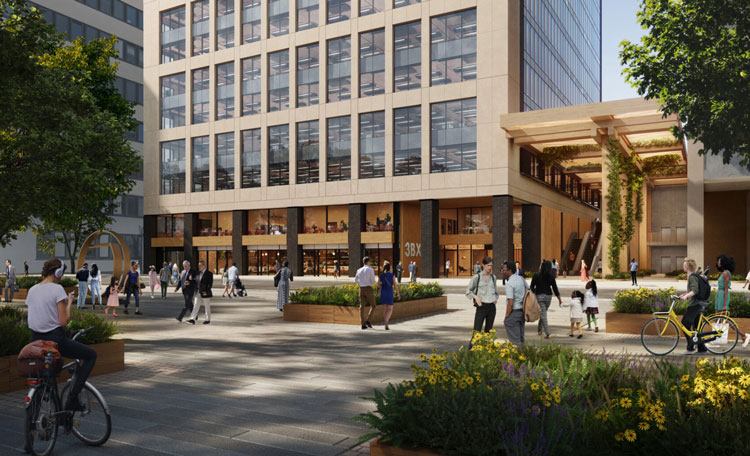By the end of the decade, we could see a surplus of 330 million square feet (msf) of vacant office space, most of which hasn’t kept pace with modern space use and trends. At the same time, the U.S. faces a housing shortage, with estimates ranging from 1 to 6 million units in supply-vs.-demand discrepancies. As building owners and potential investors explore what to do with empty commercial real estate space, many consider converting office buildings into multifamily uses.
But an office-to-multifamily conversion can be a complicated and costly process and includes many considerations—from building infrastructure, to zoning, to local market demand, and more. It’s not a quick process—construction can take 8 to 16 months—however, initial evaluations to help determine whether to proceed can be done quickly if owners have the right partners.
Cushman & Wakefield’s Project & Development Services (PDS) team has a streamlined process for owners and investors to inexpensively evaluate and quickly decide if a building should be further explored for a full conversion. Our firm has spent significant resources evaluating conversion opportunities and can estimate cost, time, risks and likely returns.


Insights
Converting Offices to Housing: What You Need to Know
STEPS FOR CONVERSION EXPLORATION—OFFICE TO MULTIFAMILY
Step One: Conversion Exploration
Cushman & Wakefield research teams can look at local markets to see where there is both an unmet demand for housing and office buildings with high vacancy, and then develop a plan to convert from office to multifamily for owners or potential new owners. Identifying a building to convert may happen a few ways—existing building owners can identify buildings that are challenging to lease, lenders and banks may take control of a distressed or stressed asset and want to explore other options.
Step Two: Market Analysis
Drawing on our market intelligence and capital markets research, we determine which locations, markets and submarkets have high demand for multifamily housing. We explore the types of space that are in demand—affordable or senior housing, for example—to further vet identified properties and ensure that there is sufficient demand to lease multifamily units.
Step Three: Validation/Conversion Strategy
Once we identify potential conversion properties, we determine the opportunity using a low-cost scorecard tool that looks across site characteristics, including walkability, neighborhood, safety and government incentives. We also evaluate the building’s physical characteristics and technical feasibility of conversion.
Factors we consider:

After analyzing these components at a high level, we can advise if a conversion would be a sound investment in a short period of time, at little expense.
Step Four: Due Diligence
At the due diligence stage, it’s time to involve an architect, planner and engineers.
We begin to develop concept plans for the building:
- How many units will the building yield?
- What is the mix of one-, two- and three-bedroom units?
- How will the asset be positioned in the market?
- What physical characteristics will require investment? (e.g., window replacement, plumbing and electrical upgrades, etc.)
- Is there adequate residential parking?
- Do the ceiling heights work?
- Do the mechanical, electrical and plumbing systems work for a residential conversion?
- Are there enough elevators and are they well-located?
This last step can often take a few months, and generally requires an initial investment to assemble the conversion team. But if involved early, Cushman & Wakefield can provide owners with confidence to know whether to proceed with an office-to-multifamily conversion.
Cushman & Wakefield is a partner for CRE owners and investors to identify and execute on the best uses for their assets. If assets can be converted into multifamily housing, we may help to solve the nation’s housing shortage, reduce vacant, unneeded spaces, and help improve our local cities and communities.
Authors
Related Insights
Research • Investment / Capital Markets
Top Trends Across Cushman & Wakefield’s Multifamily Portfolio

MarketBeat
MarketBeat
UK Regional Offices MarketBeat

Research
Trade Shifts: U.S. Occupier Demand & Central London Offices
Insights • Workplace
MarketBeat
Office Real Estate MarketBeat in Aix-Marseille Region
Research • Sustainability / ESG
Elevating Birmingham's Urban Inclusivity

Research

Article
Does your building qualify for a life sciences conversion?

Research • Investment / Capital Markets

Article
Contextualizing Development Risk

Insights • Workplace
Obsolescence Equals Opportunity
Related Services
Project & Development Services
Multifamily
Capital Markets
We make more deals by accessing more investors, creating more connections and providing exclusive, local insights. We relentlessly make opportunities for our clients. Every day. All over the world.


